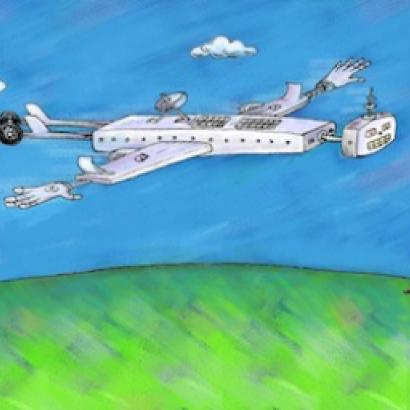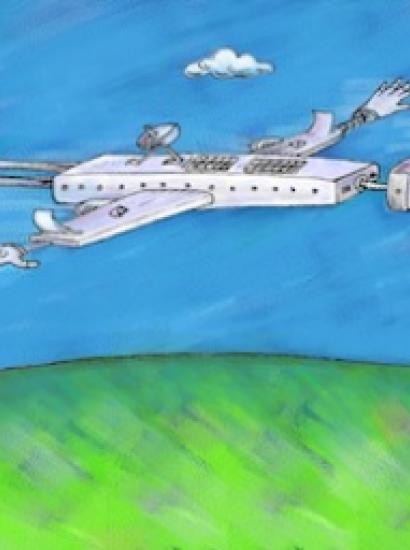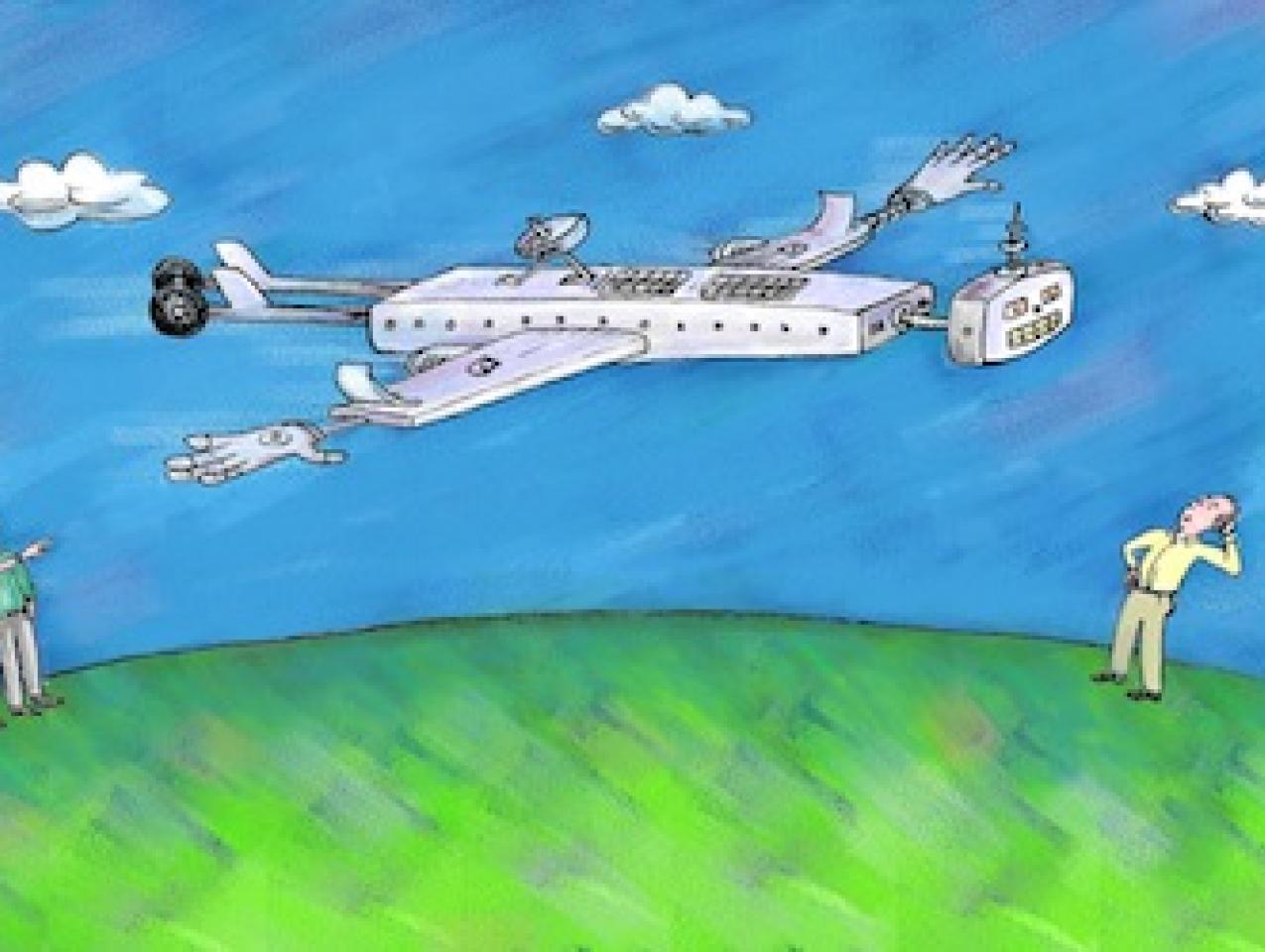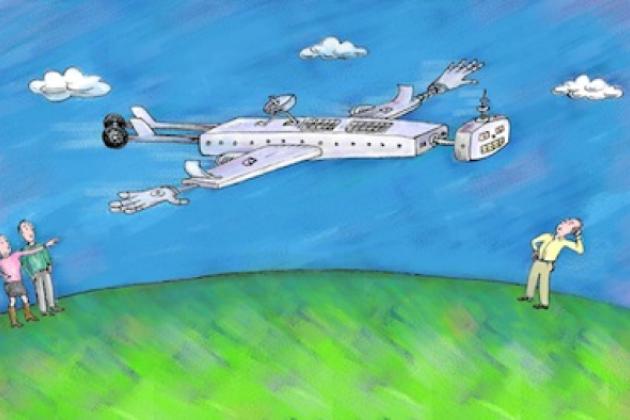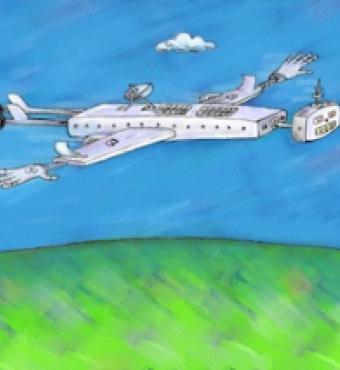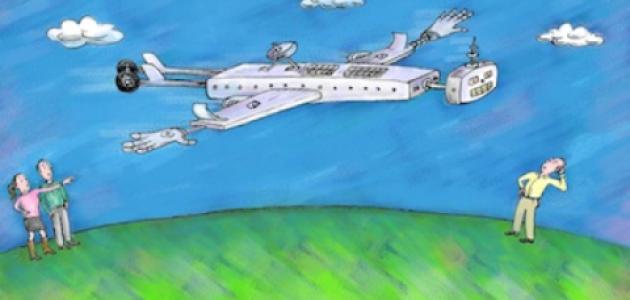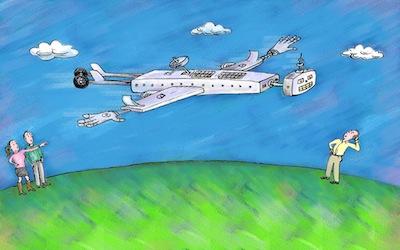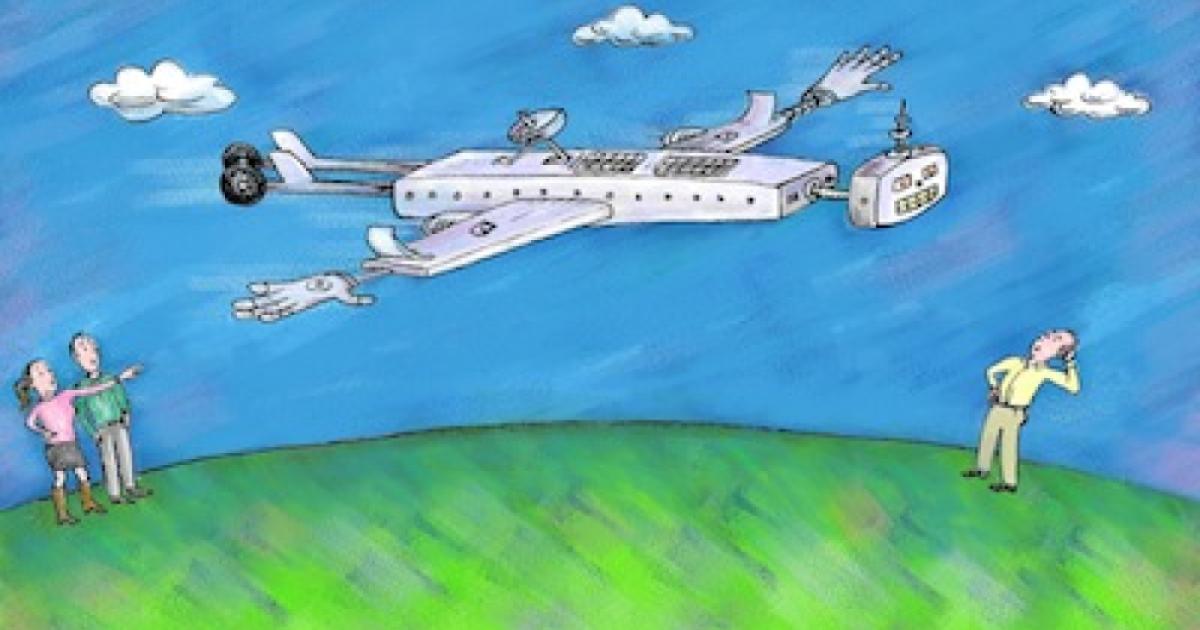- International Affairs
- US Foreign Policy
- Law & Policy
- Civil Rights & Race
In the game of life and evolution there are three players at the table: human beings, nature, and machines. I am firmly on the side of nature. But nature, I suspect, is on the side of the machines.
—George Dyson in Darwin Among the Machines
If you want to understand how human beings stack up next to machines in the conduct of modern warfare, consider this: In World War II, it took a fleet of 1,000 B-17 bombers—flown, navigated, and manned by a crew of 10,000 men—to destroy one Axis ground target. American bombs were so imprecise that, on average, only one in five fell within 1,000 feet of where they were aimed. Aerial bombing was a clumsy affair, utterly dependent on the extraordinary labor of human beings.
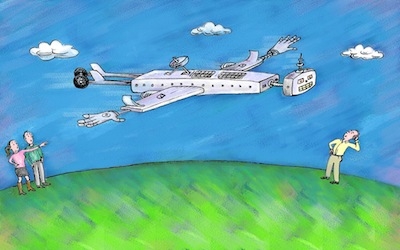
Illustration by Barbara Kelley
Just one generation later, that was no longer true. In the Vietnam War, it took thirty
F-4 fighter-bombers, each flown and navigated by only two men, to destroy a target. That was a 99.4 percent reduction in manpower. The precision of attack was also greatly enhanced by the first widespread use of laser-guided munitions.
After Vietnam, humans’ connection to air war became more attenuated, and less relevant. In the Gulf War, one pilot flying one plane could hit two targets. The effectiveness of the human-machine pairing was breathtaking. A single “smart bomb” could do the work of 1,000 planes dropping more than 9,000 bombs in World War II. By the time the United States went to war in Afghanistan and Iraq, one pilot in one plane could destroy
six targets. Their weapons were guided by global positioning satellites orbiting thousands of miles above the surface of the earth. And increasingly, the pilots weren’t actually inside their planes anymore.
The historical trend is sobering. As aircraft and weapons have become more precise, human beings have become less essential to the conduct of war. And that may suit the military just fine.
Human Beings: Necessary for War?
In 2009, the Air Force released its “Flight Plan” for unmanned aircraft systems, a big-picture forecast about how the service will fight wars by the year 2047. It dutifully points out that humans currently remain “in the loop” on strike missions—that is, they still actually fly airplanes. But within the next five to ten years, the Air Force intends that one pilot will four aircraft. He or she will not sit in a cockpit, or even in a seat thousands of miles away made up to look like one. The pilot will communicate with the fleet via a computer terminal and a keyboard, maybe even a smartphone.
After issuing a flight plan, the aircraft will be responsible for completing many important aspects of the mission unassisted: taking off, flying to the target, avoiding detection by adversaries. The Air Force’s goal is for one human controller and a fleet of drones to be able to attack thirty-two targets with near-perfect precision.
In this scenario, the pilot will be “on the loop.” It is a rather disquieting place to be, since it is only a step away from being out of the loop—which is where, by mid-century, when the Air Force’s plan takes full effect, people will be. A single “mission commander” will communicate with a “swarm” of autonomous unmanned systems. These self-operated flying robots, the size of flies or moths, will be able to fly inside buildings, conduct reconnaissance, and mass upon their targets with insect-like efficiency. In some cases, the swarm won’t communicate with a human being, but with other drones.
The Air Force is already developing a fleet of tiny, semi-autonomous warriors. In April 2011, it issued a request for proposals for a drone that sneaks up on an enemy and sprays him with a trackable dust or powder that tells larger armed, orbiting drones where to aim their missiles. The Air Force calls the human a “passive” participant in the swarm’s behavior. That human mission commander will not actually command anything.
It seems implausible that the U.S. military would deliberately reduce the warrior’s role in war to the point that people become mere monitors of autonomous, man-made technology. But this is precisely where the evolutionary trend has been heading ever since the 1940s. Autonomy is the logical endpoint of a century of technological progress. And since taking human beings out of the loop means making them safer, it is an attractive goal.
The Consequences of Autonomous Warfare
While there is a tremendous amount of money and thought going towards the construction of new drones, comparatively less attention is being paid to managing the consequences of autonomous warfare. The proliferation of drones raises profound questions of morality, hints at the possibility of a new arms race, and may even imperil the survival of the human species. Many of the most important policy judgments about how to adapt the machines to a human world are being based on the assumption that a drone-filled future is not just desirable, but inevitable.
This dilemma is not restricted to the battlefield. Civilian society will eventually be deposited in this automated future, and by the time we’ve arrived, we probably won’t understand how we got there, and how the machines gained so much influence over our lives.
This is the fate that Bill Joy, the co-founder and former chief scientist of Sun Microsystems, described in his dystopian essay “Why the Future Doesn’t Need Us,” published in Wired magazine in 2000. Joy’s fear—as controversial now as it was then—is that human beings will sow the seeds of their own extinction by building machines with the ability to think for themselves, and eventually to reproduce and destroy their creators. It is essentially the same nightmare that James Cameron imagined in the Terminator series.
Joy begins his essay with an unwillingness to accept that human beings would ever consciously allow this to happen. But then he visits a friend, the futurist Danny Hills, who co-founded Thinking Machines Corporation. Hills tells Joy the future will not be announced with a Hollywood bang but that “the changes would come gradually, and that we would get used to them.”
The military has followed this path, gradually adjusting as it pushes humans out of certain tasks that a generation ago would have never been handed over to machines. The robots and nanobots that Joy imagined exist today as unmanned aerial vehicles, more commonly known as drones. The Air Force studiously avoids the term drone—and encourages others to do the same—because it connotes a single-minded insect or parasite that is beyond the control of people. Drone operators prefer “remote piloted aircraft,” which reminds us that as independent as the missile-wielding flying robot might seem, there is always a human being at the end of its digital leash. That is, of course, until the human becomes passive to the swarm.
In any case, it is not an overstatement to say that the people building and flying these unmanned machines are wrestling now with the very fundamentals of what it means to be human. And while senior military officials and policymakers swear up and down that humans will always have at least a foot in the loop, and that the military would never deploy robots that can select and attack targets on their own, the evidence suggests otherwise.
Machines and the Future
In his 2009 book Wired for War: The Robotics Revolution and Conflict in the 21st Century, P. W. Singer documents at least five formal programs or plans put in motion by the military and the Defense Department in recent years to build autonomy into weapons systems. Indeed, the Joint Forces Command wrote a report in 2005 suggesting that “autonomous robots on the battlefield will be the norm within twenty years,” Singer writes. “Its official title was somewhat amusing, given the official mantra one usually hears on the issue: ‘Unmanned Effects: Taking the Human Out of the Loop.’”
The military is well on track to achieve the future state imagined in its grand plan—and so is society at large. Technology does not stand in the way. “The capability is there,” says Lindsay Voss, the senior research analyst at the Association for Unmanned Vehicle Systems International, which promotes the use of unmanned systems in non-military settings. The question is whether we trust it.
To a certain degree, the unmanned systems flying combat missions today over Iraq, Afghanistan, and Pakistan, where they’ve become central to the war effort, are already autonomous. “They’re riding on beefy autopilots,” says Kyle Snyder, the director of unmanned aerial systems programs at Middle Tennessee State University. The drones are using technology similar to that in commercial airplanes. They know how to hold a heading and altitude without human intervention.
But Snyder, who is educating the next generation of drone-makers and operators, says flight control technology is rapidly becoming more independent. “What makes [the next generation of aircraft] so smart is how they interact with the rest of air traffic and other unmanned aerial vehicles,” he says. “Right now, we’ve got a human in the loop, looking at screens or out windows, seeing traffic and listening to air traffic control. The new technology makes UAVs autonomous, because it lets them understand what the [human] air traffic controller is saying: ‘You’ve got traffic at 12 o’clock. It’s a 777, and it’ll pass you.’”
Snyder is not talking about drones in the combat theatre, but in domestic U.S. air space. The military has paved the way for the proliferation of unmanned systems for domestic use. Once the Federal Aviation Administration changes airspace regulations to accommodate, and to adapt to, remote-piloted and autonomous aircraft, drones will move from the battlefield to the friendly skies.
While the idea of boarding a Delta Airlines flight with no pilots might terrify today’s traveler, in the near term—perhaps over the next two decades—many experts consider it likely that FedEx or UPS will replace some of their manned cargo fleet with unmanned planes. “The public is going to have to be warmed up to the idea that they’re flying on an aircraft sharing the sky with aircraft that are unmanned,” says Rick Prosek, who manages the FAA’s Unmanned Aircraft Program Office. “You’ve got to get a toe into the water.”
Listening to Prosek, one hears that gradual shift towards the inevitable. “When I was a kid and you got onto an elevator, there was a guy sitting on the stool who asked you what floor to go to,” he says. “Now most people are not aware there ever was an elevator operator out there.”
Prosek calls it “a far larger step” to accept sharing the airspace with fully autonomous vehicles, capable of deciding on their own how fast to fly, how to avoid rough weather, and how to steer clear of other planes. But that day, which he and so many experts have anticipated for years, is coming. “We used to joke that the air crew of the future would be one pilot and one dog. The dog would be there to bite the pilot if he tried to do anything.”
Currently, the FAA prohibits anyone not affiliated with the federal government from flying an unmanned aircraft, unless it is for the purpose of experimental research. The operators are expressly forbidden from generating any profit, which has largely sidelined most entrepreneurs and kept the commercial drone business from taking off. But once the FAA lifts those restrictions, experts predict that a proliferation of drone technology will eclipse what the military has experienced thus far.
Using the Air Force’s own flight plan as a rough guide, by 2040:
Agricultural producers will use small hover drones to monitor crop yields and herd livestock.
SWAT teams will send mechanical insects equipped with video cameras to creep inside a building during a hostage standoff.
The U.S.-Mexico border will be monitored by a fleet of robotic birds, which may stay aloft for days or weeks without recharging their batteries.
Traffic helicopters will no longer require a human pilot.
And this forecast is probably too conservative. Right now, law enforcement agencies and the military are using experimental, autonomous robots for surveillance missions with domestic applications, such as border patrol and hostage rescue.
Inspired by Nature
Designers are taking their inspiration from nature, a field of research known as biomimicry. They are building drone “spiders” to climb up tree trunks, skitter to the end of a branch, and then “perch and stare” at their surroundings. The Air Force’s Wasp III, a collapsible prop-plane, is modeled after a soaring bird. It weighs only a few pounds, and its wings are made of a foam composite. The Wasp patrols from above using an internal GPS and navigation system, as well as an autopilot. The Wasp can function autonomously from take-off to landing.
The Wasp actually looks more like a hawk. “It kind of circles up in the air,” Voss says. “If you didn’t know what it was, you would think it was just a bird. They’ll attract other hawks in the area, because they’re territorial. And then other birds will come to see what’s going on, because they think it’s looking for prey.”
Scientists have been experimenting with live organisms, too. Researchers at Cornell University have implanted control circuitry into moth pupae; when the creatures metamorphose into flying insects, the devices stay in place, emitting an electrical charge that is used to flap the moths’ wings and control direction.
AeroVironment, based in Simi Valley, California, this year unveiled its “nano-hummingbird,” a spy-craft with a 6.5-inch wingspan and video camera in its belly. The Defense Department gave Boston Dynamics, a leading robotics company, a contract to design a Cheetah-like robot, capable of running up to 70 miles per hour, as well as a humanoid robot, called Atlas, that will walk upright, climb, squeeze between walls, and use its hands.
If the drone experts’ predictions are on track with those of futurists like Joy and Hills, then by 2047, animal-like machines will be practically indistinguishable from their sentient counterparts. In fact, Joy predicts that the potential for a crossover will come as soon as 2030. By then, what he calls “radical progress in molecular electronics—where individual atoms and molecules replace lithographically drawn transistors”—will allow us “to be able to build machines, in quantity, a million times as powerful as the personal computers of today.” Machines will process information so powerfully and so quickly that, in effect, they will begin to learn.
“Given the incredible power of these new technologies,” Joy asks, “shouldn’t we be asking how we can best coexist with them?”








